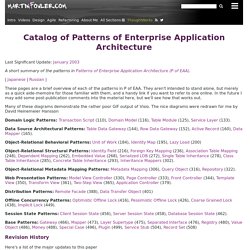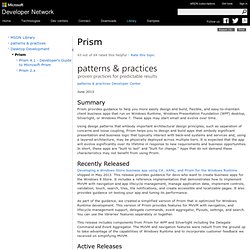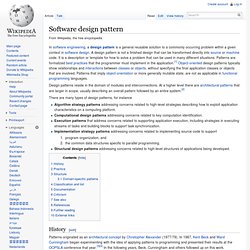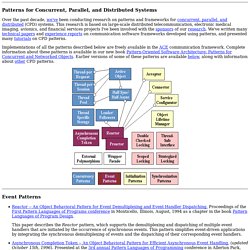

4. Fundamentals - Diploma Thesis: Evaluation of Plug-In Architectures for a Test Suite. 4.1 Overview Plug-in architectures do not have to be designed and implemented from scratch since already some sophisticated frameworks exist.

The architecture of a plug-in framework shall work with all applications of the intended domain. The Test Suite product is in the domain of Windows-based applications. It is very difficult to design a framework architecture that is applicable for a variety of applications. This means that flexibility and extensibility are essential for a framework design [GHJV95, p. 27]. A framework that addresses them using design patterns is far more likely to achieve high levels of design and code reuse than one that doesn't. Basic knowledge of the most important design patterns and concepts in the field of plug-in architectures help to evaluate different plug-in frameworks. 4.2 Dependency Injection The Dependency Injection (DI) pattern arose from the Java community when they tried to find alternatives to the high complex enterprise Java world. Home - Enterprise Integration Patterns.
Catalog of Patterns of Enterprise Application Architecture. Last Significant Update: January 2003 A short summary of the patterns in Patterns of Enterprise Application Architecture (P of EAA). | Japanese | Russian | These pages are a brief overview of each of the patterns in P of EAA.

They aren't intended to stand alone, but merely as a quick aide-memoire for those familiar with them, and a handy link if you want to refer to one online. In the future I may add some post-publication comments into the material here, but we'll see how that works out. Many of these diagrams demonstrate the rather poor GIF output of Visio. Domain Logic Patterns: Transaction Script (110), Domain Model (116), Table Module (125), Service Layer (133).
Prism. Patterns & practices Developer Center June 2013 Prism provides guidance to help you more easily design and build, flexible, and easy-to-maintain client business apps that run on Windows Runtime, Windows Presentation Foundation (WPF) desktop, Silverlight, or Windows Phone 7.

These apps may start small and evolve over time. Using design patterns that embody important architectural design principles, such as separation of concerns and loose coupling, Prism helps you to design and build apps that embody significant presentation and business logic that typically interact with back-end systems and services and, using a layered architecture, may be physically deployed across multiple tiers. It is expected that the app will evolve significantly over its lifetime in response to new requirements and business opportunities. Developing a Windows Store business app using C#, XAML, and Prism for the Windows Runtime shipped in May 2013. Stay informed and up to date about Prism and patterns & practices.
MVVM Light Toolkit - Home. Software design pattern. There are many types of design patterns, for instance Algorithm strategy patterns addressing concerns related to high-level strategies describing how to exploit application characteristics on a computing platform.Computational design patterns addressing concerns related to key computation identification.Execution patterns that address concerns related to supporting application execution, including strategies in executing streams of tasks and building blocks to support task synchronization.Implementation strategy patterns addressing concerns related to implementing source code to support program organization, andthe common data structures specific to parallel programming.Structural design patterns addressing concerns related to high-level structures of applications being developed.

History[edit] Although design patterns have been applied practically for a long time, formalization of the concept of design patterns languished for several years.[5] Practice[edit] Structure[edit] Criticism[edit] Object Oriented Design. Design Patterns. In software engineering, a design pattern is a general repeatable solution to a commonly occurring problem in software design. A design pattern isn't a finished design that can be transformed directly into code. It is a description or template for how to solve a problem that can be used in many different situations. Uses of Design Patterns Design patterns can speed up the development process by providing tested, proven development paradigms.
Effective software design requires considering issues that may not become visible until later in the implementation. Often, people only understand how to apply certain software design techniques to certain problems. In addition, patterns allow developers to communicate using well-known, well understood names for software interactions. Design Patterns Catalog. Design Patterns, Pattern Languages, and Frameworks. Patterns for Concurrent, Parallel, and Distributed Systems. Douglas C.

Schmidt, ``Wrapper Facade: A Structural Pattern for Encapsulating Functions within Classes,'' C++ Report, SIGS, Vol. 11, No 2, February, 1999. This paper describes the Wrapper Facade pattern. The intent of this pattern is to encapsulate low-level, stand-alone functions with object-oriented (OO) class interfaces.
Common examples of the Wrapper Facade pattern are C++ wrappers for native OS C APIs, such as sockets or pthreads. Programming directly to these native OS C APIs makes networking applications verbose, non-robust, non-portable, and hard to maintain. Reactor. Asynchronous Completion Token. Acceptor-Connector.